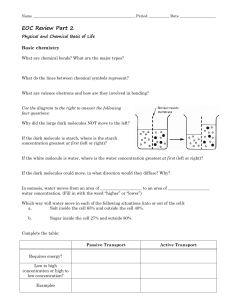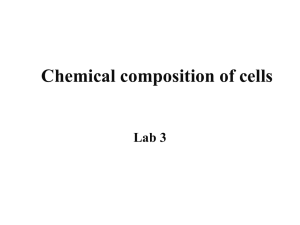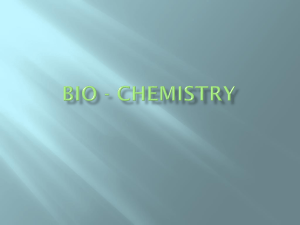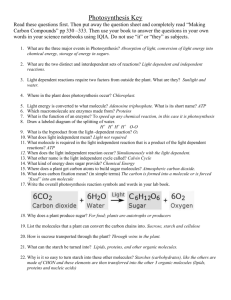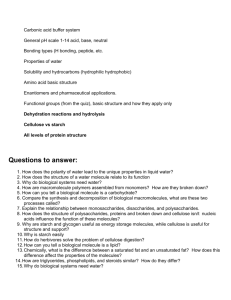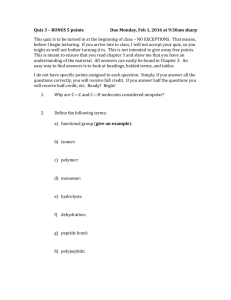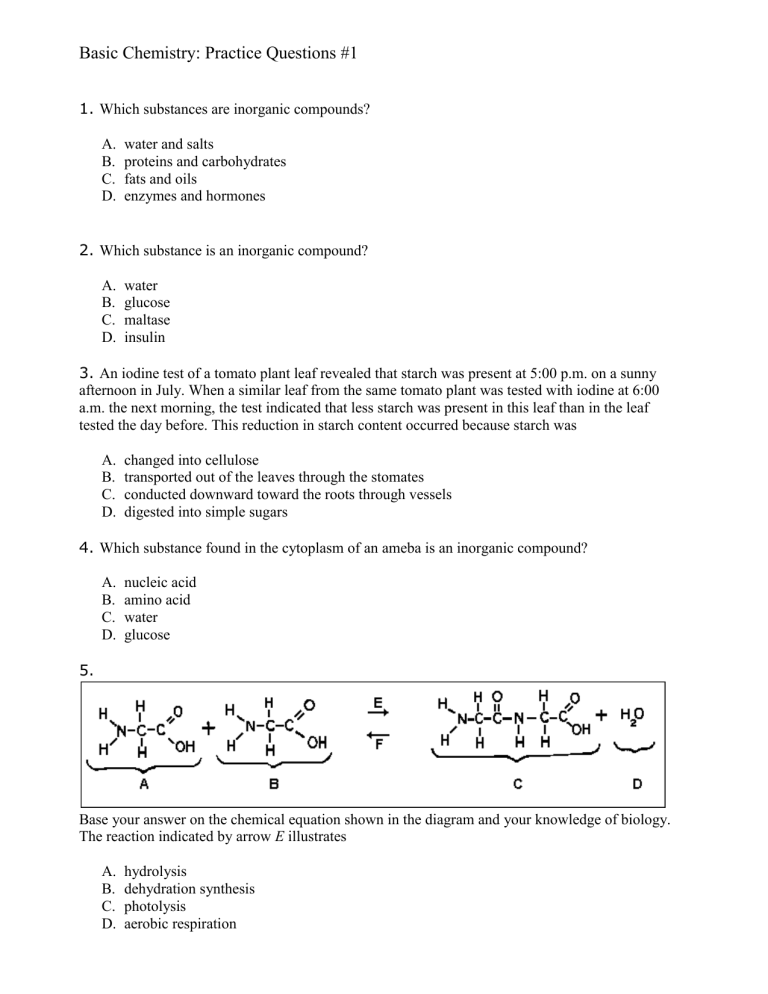
Basic Chemistry: Practice Questions #1 1. Which substances are inorganic compounds? A. B. C. D. water and salts proteins and carbohydrates fats and oils enzymes and hormones 2. Which substance is an inorganic compound? A. B. C. D. water glucose maltase insulin 3. An iodine test of a tomato plant leaf revealed that starch was present at 5:00 p.m. on a sunny afternoon in July. When a similar leaf from the same tomato plant was tested with iodine at 6:00 a.m. the next morning, the test indicated that less starch was present in this leaf than in the leaf tested the day before. This reduction in starch content occurred because starch was A. B. C. D. changed into cellulose transported out of the leaves through the stomates conducted downward toward the roots through vessels digested into simple sugars 4. Which substance found in the cytoplasm of an ameba is an inorganic compound? A. B. C. D. nucleic acid amino acid water glucose 5. Base your answer on the chemical equation shown in the diagram and your knowledge of biology. The reaction indicated by arrow E illustrates A. B. C. D. hydrolysis dehydration synthesis photolysis aerobic respiration 6. Which term best describes a solution with a pH of 5? A. B. C. D. acidic neutral basic colorless 7. Which elements are present in all organic compounds? A. B. C. D. hydrogen and oxygen nitrogen and oxygen nitrogen and carbon hydrogen and carbon 8. In which process are simple materials chemically combined to form more complex materials? A. B. C. D. synthesis pinocytosis hydrolysis cyclosis 9. Which formula represents an organic compound? A. B. C. D. Mg(OH)2 NaCl C12H22O11 NH3 10. A sample of food containing one type of a large molecule was treated with a specific digestive enzyme. Nutrient tests performed on the resulting products showed the presence of simple sugars, only. Based on these test results, the original large molecules contained in the sample were molecules of A. B. C. D. protein glucose starch DNA 11. The diagram below represents one metabolic activity of a human. Letters A and B are best represented by which row in the chart? Row Metabolic Activity A A. respiration B oxygen molecules B. reproduction hormone molecules C. excretion simple sugar molecules D. digestion amino acid molecules 12. Which statement concerning simple sugars and amino acids is correct? A. B. C. D. They are both wastes resulting from protein synthesis. They are both building blocks of starch. They are both needed for the synthesis of larger molecules. They are both stored as fat molecules in the liver. 13. In plants, simple sugars are least likely to be A. B. C. D. linked together to form proteins broken down into carbon dioxide and water used as a source of energy stored in the form of starch molecules 14. Which group contains only molecules that are each assembled from smaller organic compounds? A. B. C. D. proteins, water, DNA, fats proteins, starch, carbon dioxide, water proteins, DNA, fats, starch proteins, carbon dioxide, DNA, starch 15. The diagram below represents a portion of an organic molecule. This molecule controls cellular activity by directing the synthesis of A. B. C. D. carbohydrates minerals fats proteins 16. Which statement concerning proteins is not correct? A. B. C. D. Proteins are long, usually folded, chains. The shape of a protein molecule determines its function. Proteins can be broken down and used for energy. Proteins are bonded together, resulting in simple sugars. 17. Which row in the chart below contains correct information concerning synthesis? Row Building Blocks A. glucose molecules Substance Synthesized Using the Building Blocks DNA B. simple sugars protein C. amino acids enzyme D. molecular bases starch 18. Experiments revealed the following information about a certain molecule: It can be broken down into amino acids. It can break down proteins into amino acids. It is found in high concentrations in the small intestine of humans. This molecule is most likely A. B. C. D. an enzyme an inorganic compound a hormone an antigen 19. The sweet taste of freshly picked corn is due to the high sugar content in the kernels. Enzyme action converts about 50% of the sugar to starch within one day after picking. To preserve its sweetness, the freshly picked corn is immersed in boiling water for a few minutes, and then cooled. Which statement most likely explains why the boiled corn kernels remain sweet? A. B. C. D. Boiling destroys sugar molecules so they cannot be converted to starch. Boiling kills a fungus on the corn that is needed to convert sugar to starch. Boiling activates the enzyme that converts amino acids to sugar. Boiling deactivates the enzyme responsible for converting sugar to starch. 20. The diagram below represents the synthesis of a portion of a complex molecule in an organism. Which row in the chart could be used to identify the building blocks and product in the diagram? Row Building Blocks Product A. starch molecules glucose B. amino acid molecules part of protein C. sugar molecules ATP D. DNA molecules part of starch 21. Which statement describes starches, fats, proteins, and DNA? A. B. C. D. They are used to store genetic information. They are complex molecules made from smaller molecules. They are used to assemble larger inorganic materials. They are simple molecules used as energy sources. 22. The diagram below represents a process that occurs in organisms. Which row in the chart indicates what A and B in the boxes could represent? Row A. B. C. D. A B starch proteins starch amino acids protein amino acids protein simple sugars 23. Base your answer to this question on the information below and on your knowledge of biology. Organisms living in a bog environment must be able to tolerate nitrogen-poor, acidic conditions. Bog plants such as the Venus flytrap and sundew are able to obtain their nitrogen by attracting and consuming insects. These plants produce chemicals that break down the insects into usable compounds. Which compounds present in insects are composed of the amino acids that provide the Venus flytrap and sundew with much of their nitrogen? A. B. C. D. proteins sugars carbohydrates fats Answer Key: Basic Chemistry 1. A 13. A 2. A 14. C 3. D 15. D 4. C 5. B 6. A 7. D 8. A 16. D 17. C 18. A 19. D 20. B 9. C 10. C 11. D 12. C 21. B 22. C 23. A
